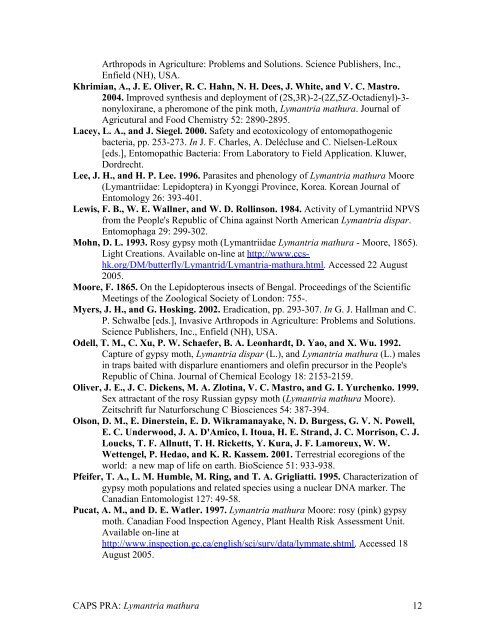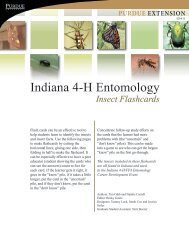Pink Gypsy Moth - aphis - US Department of Agriculture
Pink Gypsy Moth - aphis - US Department of Agriculture
Pink Gypsy Moth - aphis - US Department of Agriculture
You also want an ePaper? Increase the reach of your titles
YUMPU automatically turns print PDFs into web optimized ePapers that Google loves.
Arthropods in <strong>Agriculture</strong>: Problems and Solutions. Science Publishers, Inc.,<br />
Enfield (NH), <strong>US</strong>A.<br />
Khrimian, A., J. E. Oliver, R. C. Hahn, N. H. Dees, J. White, and V. C. Mastro.<br />
2004. Improved synthesis and deployment <strong>of</strong> (2S,3R)-2-(2Z,5Z-Octadienyl)-3-<br />
nonyloxirane, a pheromone <strong>of</strong> the pink moth, Lymantria mathura. Journal <strong>of</strong><br />
Agricutural and Food Chemistry 52: 2890-2895.<br />
Lacey, L. A., and J. Siegel. 2000. Safety and ecotoxicology <strong>of</strong> entomopathogenic<br />
bacteria, pp. 253-273. In J. F. Charles, A. Delécluse and C. Nielsen-LeRoux<br />
[eds.], Entomopathic Bacteria: From Laboratory to Field Application. Kluwer,<br />
Dordrecht.<br />
Lee, J. H., and H. P. Lee. 1996. Parasites and phenology <strong>of</strong> Lymantria mathura Moore<br />
(Lymantriidae: Lepidoptera) in Kyonggi Province, Korea. Korean Journal <strong>of</strong><br />
Entomology 26: 393-401.<br />
Lewis, F. B., W. E. Wallner, and W. D. Rollinson. 1984. Activity <strong>of</strong> Lymantriid NPVS<br />
from the People's Republic <strong>of</strong> China against North American Lymantria dispar.<br />
Entomophaga 29: 299-302.<br />
Mohn, D. L. 1993. Rosy gypsy moth (Lymantriidae Lymantria mathura - Moore, 1865).<br />
Light Creations. Available on-line at http://www.ccshk.org/DM/butterfly/Lymantrid/Lymantria-mathura.html.<br />
Accessed 22 August<br />
2005.<br />
Moore, F. 1865. On the Lepidopterous insects <strong>of</strong> Bengal. Proceedings <strong>of</strong> the Scientific<br />
Meetings <strong>of</strong> the Zoological Society <strong>of</strong> London: 755-.<br />
Myers, J. H., and G. Hosking. 2002. Eradication, pp. 293-307. In G. J. Hallman and C.<br />
P. Schwalbe [eds.], Invasive Arthropods in <strong>Agriculture</strong>: Problems and Solutions.<br />
Science Publishers, Inc., Enfield (NH), <strong>US</strong>A.<br />
Odell, T. M., C. Xu, P. W. Schaefer, B. A. Leonhardt, D. Yao, and X. Wu. 1992.<br />
Capture <strong>of</strong> gypsy moth, Lymantria dispar (L.), and Lymantria mathura (L.) males<br />
in traps baited with disparlure enantiomers and olefin precursor in the People's<br />
Republic <strong>of</strong> China. Journal <strong>of</strong> Chemical Ecology 18: 2153-2159.<br />
Oliver, J. E., J. C. Dickens, M. A. Zlotina, V. C. Mastro, and G. I. Yurchenko. 1999.<br />
Sex attractant <strong>of</strong> the rosy Russian gypsy moth (Lymantria mathura Moore).<br />
Zeitschrift fur Naturforschung C Biosciences 54: 387-394.<br />
Olson, D. M., E. Dinerstein, E. D. Wikramanayake, N. D. Burgess, G. V. N. Powell,<br />
E. C. Underwood, J. A. D'Amico, I. Itoua, H. E. Strand, J. C. Morrison, C. J.<br />
Loucks, T. F. Allnutt, T. H. Ricketts, Y. Kura, J. F. Lamoreux, W. W.<br />
Wettengel, P. Hedao, and K. R. Kassem. 2001. Terrestrial ecoregions <strong>of</strong> the<br />
world: a new map <strong>of</strong> life on earth. BioScience 51: 933-938.<br />
Pfeifer, T. A., L. M. Humble, M. Ring, and T. A. Grigliatti. 1995. Characterization <strong>of</strong><br />
gypsy moth populations and related species using a nuclear DNA marker. The<br />
Canadian Entomologist 127: 49-58.<br />
Pucat, A. M., and D. E. Watler. 1997. Lymantria mathura Moore: rosy (pink) gypsy<br />
moth. Canadian Food Inspection Agency, Plant Health Risk Assessment Unit.<br />
Available on-line at<br />
http://www.inspection.gc.ca/english/sci/surv/data/lymmate.shtml. Accessed 18<br />
August 2005.<br />
CAPS PRA: Lymantria mathura 12
















